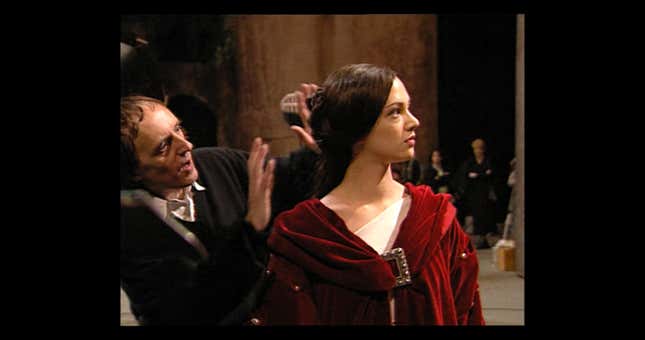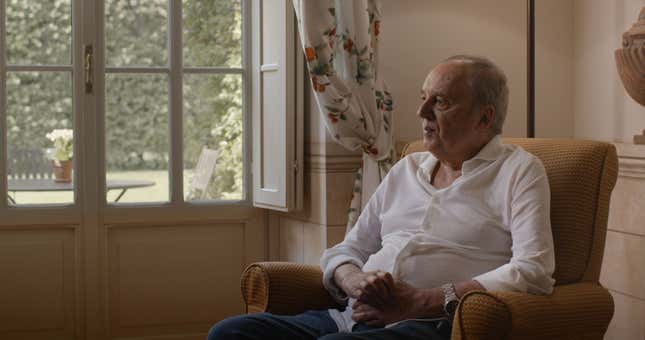One of Horror’s Greatest Masters Gets His Due in Dario Argento Panico
The influential career of Italian horror master Dario Argento gets a well-curated tribute in Dario Argento Panico. Simone Scafidi’s new documentary features interviews with the director as well as famous collaborators and admirers, including fellow boundary-pushing filmmakers Guillermo del Toro, Gaspar Noé, and Nicolas Winding Refn.
Scafidi (who also made 2019 Lucio Fulci spotlight Fulci For Fake) frames his reflections on Argento’s past with current footage of the 83-year-old artist at work on his next screenplay. We never learn its contents, but the implication is clear; Argento, whose most recent release was 2022’s Dark Glasses, is still devoted to the career that made him famous in his 20s. Dario Argento Panico charts that career from its very beginnings; even before his directorial debut, 1970 giallo The Bird With the Crystal Plumage, his screenwriting talents led him to work with one of his idols, Sergio Leone—another was Alfred Hitchcock—on 1968 spaghetti western Once Upon a Time in the West.
He was born into a show-biz family, and his father, a well-known producer, helped guide him into the film industry. But Argento’s own startling talents soon made him a star. Crystal Plumage was a hit not just in Europe but also America, an unusual distinction for an Italian film at the time, and his giallo streak continued with The Cat o’ Nine Tails and Four Flies on Grey Velvet. After he made a comedy that wasn’t well-received, he roared back by fully embracing the horror elements that would become his trademark; from 1975 to 1987, he released Deep Red, Suspiria, Inferno, Tenebrae, Phenomena, and Opera, shocking and delighting audiences worldwide.
Archival interviews and behind-the-scenes footage help give an idea of what Argento was like during this period of his life, and the impressions are further enhanced with a wonderful array of interviews: Argento’s family members (including daughter Asia, a frequent star of his later films; at one point he calls her “my favorite actress”) and his first wife Marisa Casale, as well as notable collaborators like filmmakers Lamberto Bava and Michele Soavi, Opera star Cristina Marsillach, and composer Claudio Simonetti. Unfortunately there’s not much from his late former partner Daria Nicolodi, though Asia does shed some light on why Suspiria—the film her parents created together, and far and away Argento’s best-known title—caused so much lasting tension in their relationship.
Mixed in with the biographical details are explorations of Argento’s artistry, with del Toro in particular breaking it all down like the world’s coolest film professor. Argento, he explains, crafts “a cosmic sense of an angry, evil universe” (elsewhere, he describes that universe as “malignant” and insane”), adding “everything in Argento’s movies is trying to kill you.” Citing Suspiria as the film that introduced him to what would soon become one of his cinematic idols, del Toro praises Argento’s colorful style and daring camerawork, as well as the way his films create their own reality—and dare you not to believe in it: “It feels incredibly surreal but incredibly cohesive. You don’t question it.”

While Dario Argento Panico treats its subject with great reverence, it also doesn’t shy away from addressing something that every Argento fan is painfully aware of: after Opera, the quality of his movies began to decline. Various reasons are floated, including the death of Argento’s father in 1987, changes in the Italian entertainment industry that favored funding more TV-friendly projects, shifting tastes among audiences, and—as Asia suggests—the simple fact that her father “mellowed over time.” But Panico, which includes a lovely vintage clip of Argento explaining “panic” versus “terror,” points back at Argento’s full body of work, reminding us that his classics will always be towering, unique, and timeless—an achievement that even something as regrettable as 2012’s Dracula 3D can’t tarnish.
Dario Argento Panico arrives February 2 on Shudder. The horror streamer also has a curated giallo section that includes several Argento films.
Want more io9 news? Check out when to expect the latest Marvel, Star Wars, and Star Trek releases, what’s next for the DC Universe on film and TV, and everything you need to know about the future of Doctor Who.
The influential career of Italian horror master Dario Argento gets a well-curated tribute in Dario Argento Panico. Simone Scafidi’s new documentary features interviews with the director as well as famous collaborators and admirers, including fellow boundary-pushing filmmakers Guillermo del Toro, Gaspar Noé, and Nicolas Winding Refn.
Scafidi (who also made 2019 Lucio Fulci spotlight Fulci For Fake) frames his reflections on Argento’s past with current footage of the 83-year-old artist at work on his next screenplay. We never learn its contents, but the implication is clear; Argento, whose most recent release was 2022’s Dark Glasses, is still devoted to the career that made him famous in his 20s. Dario Argento Panico charts that career from its very beginnings; even before his directorial debut, 1970 giallo The Bird With the Crystal Plumage, his screenwriting talents led him to work with one of his idols, Sergio Leone—another was Alfred Hitchcock—on 1968 spaghetti western Once Upon a Time in the West.
He was born into a show-biz family, and his father, a well-known producer, helped guide him into the film industry. But Argento’s own startling talents soon made him a star. Crystal Plumage was a hit not just in Europe but also America, an unusual distinction for an Italian film at the time, and his giallo streak continued with The Cat o’ Nine Tails and Four Flies on Grey Velvet. After he made a comedy that wasn’t well-received, he roared back by fully embracing the horror elements that would become his trademark; from 1975 to 1987, he released Deep Red, Suspiria, Inferno, Tenebrae, Phenomena, and Opera, shocking and delighting audiences worldwide.

Archival interviews and behind-the-scenes footage help give an idea of what Argento was like during this period of his life, and the impressions are further enhanced with a wonderful array of interviews: Argento’s family members (including daughter Asia, a frequent star of his later films; at one point he calls her “my favorite actress”) and his first wife Marisa Casale, as well as notable collaborators like filmmakers Lamberto Bava and Michele Soavi, Opera star Cristina Marsillach, and composer Claudio Simonetti. Unfortunately there’s not much from his late former partner Daria Nicolodi, though Asia does shed some light on why Suspiria—the film her parents created together, and far and away Argento’s best-known title—caused so much lasting tension in their relationship.
Mixed in with the biographical details are explorations of Argento’s artistry, with del Toro in particular breaking it all down like the world’s coolest film professor. Argento, he explains, crafts “a cosmic sense of an angry, evil universe” (elsewhere, he describes that universe as “malignant” and insane”), adding “everything in Argento’s movies is trying to kill you.” Citing Suspiria as the film that introduced him to what would soon become one of his cinematic idols, del Toro praises Argento’s colorful style and daring camerawork, as well as the way his films create their own reality—and dare you not to believe in it: “It feels incredibly surreal but incredibly cohesive. You don’t question it.”

While Dario Argento Panico treats its subject with great reverence, it also doesn’t shy away from addressing something that every Argento fan is painfully aware of: after Opera, the quality of his movies began to decline. Various reasons are floated, including the death of Argento’s father in 1987, changes in the Italian entertainment industry that favored funding more TV-friendly projects, shifting tastes among audiences, and—as Asia suggests—the simple fact that her father “mellowed over time.” But Panico, which includes a lovely vintage clip of Argento explaining “panic” versus “terror,” points back at Argento’s full body of work, reminding us that his classics will always be towering, unique, and timeless—an achievement that even something as regrettable as 2012’s Dracula 3D can’t tarnish.
Dario Argento Panico arrives February 2 on Shudder. The horror streamer also has a curated giallo section that includes several Argento films.
Want more io9 news? Check out when to expect the latest Marvel, Star Wars, and Star Trek releases, what’s next for the DC Universe on film and TV, and everything you need to know about the future of Doctor Who.
